In an another entry I quoted a Latin phrase which sparked some additional conversation. This is a good opportunity to reenter the Sabine flow of things on WDTPRS, for I am indeed back at the Sabine Farm.
I quoted: Vae tibi tam nigrae, dicebat caccabus ollae.
Commenter Jeff offered:
“’Alas, so black you are,’ said the pot to the kettle.”
Which is fine, though I would do it more like:
“’Woe to you, so black you are!’ said the fry pan to the cook pot.”
I am not dead sure about frying pan and cooking pot for these instruments, but I am guessing based on my reading of a recipe in the late 4th early 5th century cookbook attributed to the 1st century Apicius, De re coquinaria.
Here is the recipe. Let me know what you think – aside from the fact that it looks pretty good. Did I get the pans right in your opinion?
3. Gruem vel anatem ex rapis: lavas, ornas et in olla elixabis cum aqua, sale et anetho dimidia coctura. rapas coque, ut exbromari possint. levabis de olla, et iterum lavabis, et in caccabum mittis anatem cum oleo et liquamine et fasciculo porri et coriandri. rapam lotam et minutatim concisam desuper mittis, facies ut coquatur. modica coctura mittis defritum ut coloret.
ius tale parabis : piper, cuminum, coriandrum, laseris radicem, suffundis acetum et ius de suo sibi, reexinanies super anatem ut ferveat. cum ferbuerit, amulo obligabis, et super rapas adicies. piper aspargis et adponis.
See what I mean?
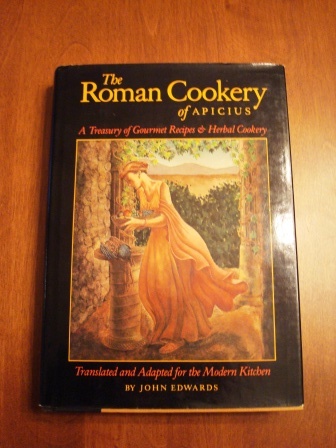 I could call that caccubus a roasting pan, I suppose, but I think frying pan fits.
I could call that caccubus a roasting pan, I suppose, but I think frying pan fits.
Now that hunting season is coming, and some ducks and other birds will be coming my way to die and to be eaten – bless them – I might have to try this. On a shelf I have the English edition of Apicius someone worked up. This recipe is included!
I’ll let you work on your own perfect versions of the recipe for Crane or Duck with Turnips before I post what this English edition worked up with modern measures.
Horace might have had something like this at the original Sabine Farm!
Maybe Augustine ate something like this in North Africa, at least before his enforced poverty in his monastic mode in Hippo.
I don’t say this idly, either.
And if he did, I bet he would have used implements like these which follow.
These I found in the British Museum a few short days ago. They were found in the site of ancient Carthage. One dish is inscribed with the family name Cresconius, who were prominent in the late fourth and early fifth centuries.
This hoard of silver was could have been hidden when the Vandals swept through Carthage (on their way also to Hippo, where Augustine died in 430 during the siege). More likely is that it was squirred away around 400 during the Donatist controversy Augustine fought in so strenuously. Remember that in 405/06 Augustine wrote an anti-Donatist work called Contra Cresconium grammaticum et donatistam.
Did this silver belong to the fellow against whom Augustine wrote? Possibly.
In the meantime, Sabine autumn is setting in with splendor.
Here come the apples on the tree next to the chapel. They are wonderful and I am picking and cooking with them. More on that below.
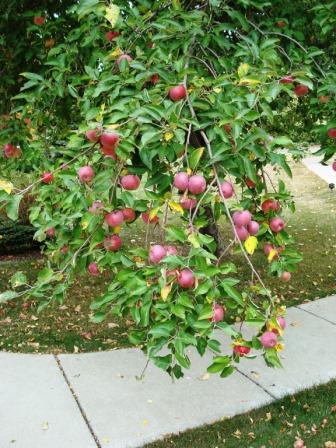
Colors are coming. I love this time of year.

Weather can be dramatic, which adds to the vistas.


Tonight I am not making crane, but rather a stuffed pork roast.
Pork was the default meat for the ancient Romans, by the way, just as it is in Chinese. Romans didn’t like to eat beef. Anyway, after my long absence, I had to get some groceries and found this roast at an absurdly low sale price and figured I could eat it for a few days, after observing the Feast of the Archangel Michael. The apples will be reduced with some peppers I grew, along with herbs such as thyme and a little lemon peel and perhaps a touch of gin for the botanicals and its stringency at just the right moment. The stuffing has rosemary, parseley, sage, thyme and fennel, all from the garden.
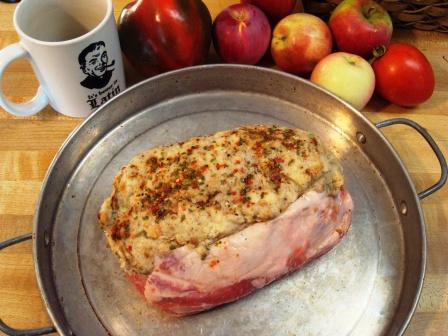
For the jansenistic types who hate good food cheaply but creatively made, or the idea that someone somewhere might be eating a decent meal, I figure this whole thing cost about $6, including the bread, excluding the cost of seeds at the beginning of spring and the price of about two ounces of gin (though I use more to make a martini in honor of the angelic choir). Dunno what the gas for the oven cost.
I might use a few table spoons of flour to make gravy at the end.
Whew! This is getting expensive!
Still… it’ll feed me for probably three days, I think.
Yes, I think I’ll have that martini now.
Cheers!
UPDATE:
Here are the results.
But first, someone asked how I made the apple sauce. Simple. I peeled and cored the apples, cut them up, tossed them in the pan with some stuff, added water cooked them down. Easy peasy.
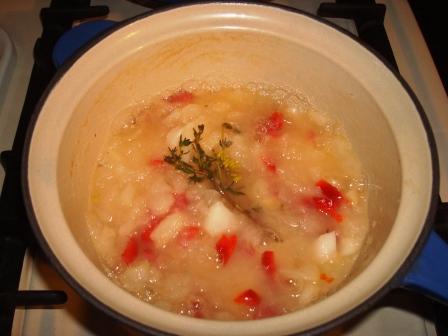
The stuffed pork roast after a 350 degree oven for … a while.

Plated and ready to go down the little red lane. I had some juice and scrapings from the pan, but I had to get some gravy I made another time and froze. Just didn’t have enough.
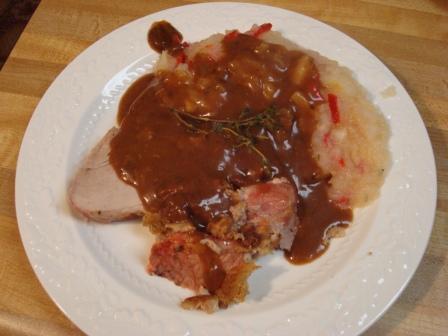
And a shot from this morning, because it was so beautiful.


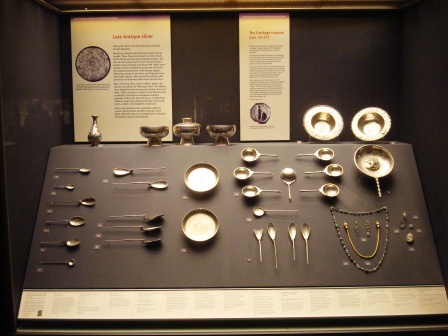

































My frozen pizza was pathetic. Looks great, Father! Cheers back at ya! Welcome home.
Looks excellent, Father! What wine will you serve? I have yet to find something decent to serve with pork, “the other white meat”. Incidentally, I will be barbecuing pork this evening myself.
Cathy: And I bet it cost more too.
I am not trying to rub it in. I am just making a point.
Right now, I happen to have some time to cook. But I sure do know what it is like to pop that frozen ‘za in and save some … thyme.
BTW… I thought of you a few times when seeing depictions of St. Catherine of Alexandria, with her wheel, when I was in the National Gallery in London.
Geoffrey: I hadn’t thought of wine for tonight. But I have a Malbec I got on sale the other day. I am getting to know this fine varietal. Perhaps I crack it.
Father,
Thanks for so splendidly upholding western culture – “pro aris et focis!”
No cult without culture!
Fraternally,
Ahem…
No culture without cult…
Sounds great, Father! Definitely beats the bowl of cereal I had for dinner. [Which was my lunch.]
By the way, love the coffee mug. I wear the shirt around my parish when I feel like annoying people. It works quite well, actually. They’ve come to accept my ways, but don’t particularly like it when I remind them of it.
When Juvenal is describing the melting down of Sejanus’ statue into cooking gear in Satire 10 he uses sartago for frying pan and matella or matula for pot, and since it is bronze he’s talking about it must be a roasting pot. [Fascinating! Thanks!]
Latin is a long lived language so I guess it is not surprising there are different words for everyday items, even no further apart than Juvenal and Apicius.
Father, those apples look delicious…not Delicious, but…well, what variety are they? That tree is so laden with fruit it’s almost touching the ground. Yum yum!
I’d never make it as a Jansenist. Too much self-pity.
Happy Michaelmas day!! I guess if you can’t shoot a fat stubble-fed goose, roast pork will do very nicely.
Dear Father:
Any bird feeder reports?
Geometricus: I don’t know the variety. They are very much like Harlsons, in some respects, an apple developed in my native place Minnesota. But I just don’t know.
They are very hard and tart, perfect for baking and.. if you are me… eating as they are. And they last for months in a cool place after picking. Last year I had apples until February.
PMcGrath: I will start feeding diligently again after the migration begins.
I had to chuckle at your reference to Apicius. Sometime back in the 1980’s I took a course on ancient Rome at our local University. I wrote a paper on Apicius’ cookbook. I still had the paper in my computer archives but unfortunately, I can no longer open the file. I had intended to send it along to you so you could have a good laugh with it. O well…
Father, have some Honeycrisp apples for me. After moving to Australia from Minnesota recently, I find I miss them the most!
Suzanne
m.a. – “I still had the paper in my computer archives but unfortunately, I can no longer open the file…”
Ah, yes, the joys of generational/format communicability in word processors.
I was chuckling about it when a thought struck me.
My attitudes towards Microsoft Word (Reasonably functional, at least in some versions.) as compared to DOS-based WordPerfect 5.1/5.2 (Oh, Sainted memory! Why were we ever forced away from you?!) is actually a pale reflection of the attitude of some people here regarding the NO as compared to TLM.
Then again, it may just be that I should get more sleep.
Still, I wonder… If the analogy holds, what then would be the analogs for PCWrite (on which I wrote college German papers ), the TRS-80 word processor on which a friend wrote some of his college papers), and the Brother electronic wp/typewriter on which plunked out more than one resume?
Actually, Father, the venerable Lewis & Short dictionary glosses cacabus (or caccabus), with a -US, as ‘a cooking pot.’
David: Yes, I saw that too. And so does the Oxford Latin Dictionary, and on the Greek side of things Liddell & Scott lists ???????? (m. or f.), ??????? (f.), ??????? (f.), ?????? (f.) — i.e. variously masculine and feminine, but nary a neuter in sight. Father Z, what are your grounds for suspecting that it should be a neuter? [Not much, apparently. o{]:¬) I was working from memory and made a mistake, it seems. I’ll correct the main entry.]
Oops… I see my Greek typing came out as gibberish once the comment was posted! Here’s a transliteration of the mangled words:
kákkabos (m. or f.), kákabos (f.), kakkábe (f.), kakábe (f.)
Sorry.
Fr,
My offer to send you horseradish roots still stands, see recipes on special message on my blog: Thoughts from an Oasis in French Catholicism: ‘Horseradish for Fr Z’
Cheers!
You should be subsisting on a diet of coarse bread and water. Well, on Sundays, anyway. All other days you ought to fast.
Food is getting more expensive and I’m starting to struggle to stay within budget. Hopefully, the garden we’ve just dug will give us a lot of veggies next year. I don’t know how vegetables grow in Minnesota, but I can tell you that Glasgow is a whole ‘nuther ball game from Southwestern Ohio. Seems to me that when I was a kid in Cincinnati, you just threw seeds on the ground and things grew with very little effort on the part of the gardener. However, at least here you can grow certain things all year ’round. That’s not an option where you are.
Your farm is beautiful and you must really enjoy having four distinct seasons. Enjoy the autumn leaves!
I have a [It”s Better in Latin] coffee mug just like yours, Fr. I’ve gotten great comments on it.
Kradcliffe: Remember that I call this the Sabine Farm, because it is my peaceful place away from Rome, just as Horace had his place in the Sabine Hills away from the maddening City. It isn’t a working farm, though there are farms nearby.
Is no one going to take a crack at an English version of the recipe?
Jane: Do you suppose that customs would allow sending plant parts like that?
Aahhh, Father, looking at these pictures and reading the words that exhibit the spirit in which they were written, you’re a man after me own heart. Slainte.
I’ll take a crack at it a little later today if I have the time.
Suzanne Sadler: have some Honeycrisp apples for me. After moving to Australia from Minnesota recently, I find I miss them the most!
Will do! They are wonderful.
I think it not an exaggeration to assert that the apples developed in Minnesota may be the best apples in the world.
The apples from next to the chapel are much like the Honeycrisp in some ways, but I think the tree is too old.
Fr. Z: “the jansenistic types who hate good food cheaply but creatively made”
Father, would it be a sin against the Eighth Commandment to use that term the next time my children complain about the food at the dinner table when we serve it with actual spices and flavorings? “Oh, [insert name of child], don’t be such a jansenistic type and eat your pork roast.”
BTW, welcome home and the roast looks scrumptious.
In Christ,
A couple of citations:
From the American Heritage Dictionary entry for “cachucha”:
“cacho, shard, saucepan, probably from Vulgar Latin *cacculus, alteration of Latin caccabus, pot, from Greek kakkabos, probably of Semitic origin; akin to Akkadian kukkubu, a small container.”
———————————————–
From Google Book Search, in the book The Insula of the Menander at Pompeii:
“It seems probable that caccabus was a fairly generic term for a cooking pot….”
I really enjoy your postings on cooking and on food.
And the Sabine Farm seems to be a great place.
Here’s my attempt, with a few things missing I’m afraid :
Take a crane or duck.
Wash it and dress it and half-boil it in a pot in water with salt and dill.
Cook the turnips and – err – drain them perhaps?
Take them out of the pot and wash them.
Put the duck into a CASSEROLE DISH (what do you think?) with oil, stock (?), leeks(?) and coriander.
Cut the turnips into pieces and put them on top of the duck to cook.
When half-cooked add something I don’t understand to add colour.
Make a sauce of pepper, cumin, coriander, somthing root, vinegar and the duck’s own stock.
Add the sauce to the duck, add peppper – and serve?
That’s all I can make of it. I did cheat and looked up a few words.
Christabel: Looking up words is not cheating, especially with this fast and dirty Latin with its odd vocabulary.
Anyone else? C’mon! Let’s have a couple other versions before I post mine.
My shot, though my vocabulary is poor on this topic.
3. Crane or duck with turnips: wash, garnish and strain into a pot with water, salt and anise until half-cooked. Cook the turnips, until tender. Remove from the pot, rinse again , and put the duck in a baking pan with olive-oil, fish-sauce, and a bit of meal and coriander. Lightly sift-down the crushed and rinsed turnip, and let bake. When partially done, put it in a fry pan to achieve a fine patina.
Prepare the sauce thus: pepper, cummin, coriander, laswerwort-root, mix together vinegar and the juice of each, pour out over the duck as you heat it. When it is bubbling, congeal it with flour [“congeal” is not right, there is English for this], and pour it over the turnips. Sprinkle with pepper and serve.
I wish I had the time and resources to do this. The free online translator sites are somewhat limited on vocabulary. The gist of what I was able to get so far…
The first part was about plucking the bird, not skinning it, right? Did it include scalding the bird in water before plucking?
Then we had something about washing? Maybe oil and/or water? Dressing the bird? Then about the pot. And some half-familiar words, hopefully related to the english words they look like (or that the translator popped out). Dill/anise, coriander, cumin, pepper, radishes?
Cooking in Latin is tough!
After all, I never learned how. Julia Child only cooked versus populum.
mpm: Good try!
Anyone else?
What sort of “stuff” went into the pan with the apples and water?
Michael: A little sweet red pepper, thyme, and a shot of gin.
Charivari: Julia Child only cooked versus populum.
Hmmm… let’s see.
Only on TV.
Think of what the former Bp. of Birmingham insisted on with EWTN’s Masses.
Perhaps there is a parallel.
Well, perhaps she used the counter against the wall in private celebrations of cooking.
Now that I think about it, she also worked with an angled mirror overhead, to provide a simple means of providing a view of what was happening on the cooktop/countertop. At least that hasn’t made it into the Mass.
Let’s tackle the recipe.
Vocabulary helps here. The L&S is not in every case so directly useful. I checked also Blaise’s Dictionary of Christian Latin, which has various non-cloassical forms. It helped me sort out a couple things.
Exbromari – has to do with Greek bromos, and thus bad smells. So, we can figure that that has to do with reducing the odor of the turnips by cooking them until they, well, don’t smell as strong. I don’t know how long that is, but when I was in England at St. Bede’s in Clapham Park, one day the nice lady made turnips for our lunch of roast chicken… sense a theme? … and she started fairly early in the morning, thus filling the house with turnip smell for hours before lunch itself when we were either used to it or the odor had diminished. I’m thinking it diminished.
Liquamen is either a liquid, like a stock, or it is a type of fermented fish sauce, like its cousin – the ketchup of the ancient world – garum, nearly exactly like Vietnamese fish sauce, the strong stuff.
For amulo look up amylus and you get starch. I think you could use flour or any thickener, corn starch maybe, though the Romans did not have corn. Maybe arrowroot, which they could have had.
Defritum or defrutum is a paraphrase for defervitum mustum, so it is grape must, juice as it starts to ferment, which is boiled down. Pliny reduces it to half its volume, but Varro reduces it to a third. I think you could get away with using regular purple grape juice with a bit of cheap red wine added and then reducing it to, say just under half its volume.
LITERAL VERSION:
You can smooth this out anyway you wish.
What I find interesting here is that when I make duck I often parboil the critter in order to get some of the fat out of it before roasting. I don’t know where or when I learned that, but I see it has been done for a long time now.
Click HERE for a modern version with modern measures you can use in your very own kitchen!
I find interesting the techniques of partially boiling then roasting, adding the defrutum for color, the partial cooking of the bird with some of the root veg and then adding the rest later. I do the same things when I do roasts of meat or fowl.
The liquamen leaves me puzzled: stock or fish sauce? The Romans used huge amounts of garum and liquamen, so their palate was tuned to that background flavor. Could be. Could be. I’d have to try it.
Conclusion:
More ducks must die.
Perhaps I could get the enormous heron that kills off our fish… hmmm.
Perhaps I could start with a couple of duck breasts and do one with stock and one with fish sauce and compare them.
Should you tackle this, and want to be very ancient Roman, be generous with the pepper especially. Romans loved pepper and they used it abundantly on just about everything. I would grind it to very course, with a mill or mortar.
A note or two about the herbs. Laser, or laserpicium, is the goo you get from asafoetida when you cut into it. However, for this recipe, we find laser root, which is asafoetida root. Also, we may really be dealing with silphium. Laser, not much used in Western cooking, is a substitute for the extract of silphium. Ancient silphium was harvested to extinction in ancient times because of its contraceptive/abortifacient applications. Asafoetida is related to ancient silphium. It was used with valerian to treat hysteria. These are all related to carrots and parseley and fennel. So, you could use probably use fennel for this recipe, instead of laser root, if you can’t get your hands on any. That would be within the flavor pallet with the anise seed.
I would pair this with a heavy red wine such as an Amarone or a huge Sicilian, a bomb of a wine.
mpm : Much better than my attempt.
I think the “congeal” word is probably “thicken” or the equivalent of “roux” these days. I still can’t work out the “colouring”. Or does it mean “brown in a frying pan”? That would make sense.
Frustrated now, Father : tell us What the Roman Recipe Really Says!
Oops, sorry Father, you were writing just as I was!
Medieval cooks, and I think Roman ones too, sometimes did like to color food. For example, you can make meat golden by brushing it with egg whites; and of course we still color cookies with food coloring.
Wine must on fowl — it might just have looked nummier. Or they might have been playing, and making it look like beef. (I’ve never painted anything with wine must, so I don’t know what kind of color you’d get after cooking.)
Er… that’d be bread that turns golden. I think.
Maureen: I don’t think Romans would have wanted to make it look like beef, since they did not prefer to eat beef, as I mentioned above. Rather, I think they liked the color and, don’t forget, the turnips would be brought closer to the color of the duck or crane which have darker meat already.
Interesting that duck with turnips– “canard aux navets,” — is terribly popular in parts of France even today.
Antiquarian: How interesting! Indeed, some things simply pair well together. Goose and sourkraut, for example. Same theory. Not to mention gin with tonic, pork with fruit, peanut butter with chocolate, etc.
Might “liquamen” be something very like Worcestershire sauce?
Christabel,
I think your suggestions are what I had in mind. About the extent of my cuisinary
vocabulary is “My, that was good!”
;>
Fr. Z,
A long time ago, I went out to eat in Rome and ordered the beef. When it appeared
it looked too white, almost like pork. So, I looked at the menu again and noticed
what it really was: oxen (buio?). It wasn’t terrible, but pork would have been much
tastier.
mpm: Well… yes and no.
While if I remember correctly fermented anchovies are at the basis of Worchestershire Sauce, I am pretty sure garum or liquamen are far more powerful, as is the Vietnamese fish sauce.
And the process of making garum was far more disgusting.
But they are certainly related.
I noticed the other day that Smith and Wollensky Steak Sauce also has anchovies in it. Interesting, no?
This is a very ancient pairing, this fermented fish and meat thing.
mpm: It sounds like you got ossobuco, a classic I enjoy from time to time. It is a cross-section of an ox shank which allows you to get at the “midolo”, or marrow in the round bone in the center. Yum.
I hope you had some of those English “pitted olives” from your recent trip to accompany the Martini, Father! No martini should be denied a decent olive!